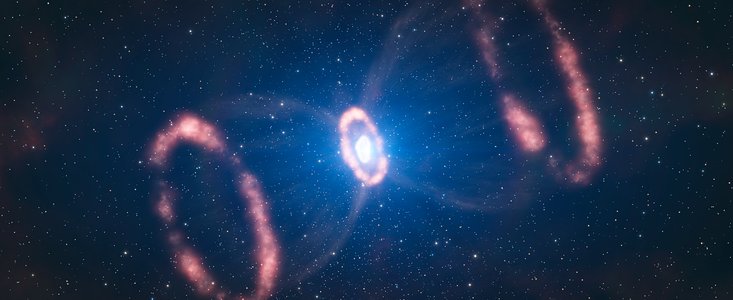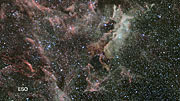Press Release
Seeing a Stellar Explosion in 3D
4 August 2010
Astronomers using ESO’s Very Large Telescope have for the first time obtained a three-dimensional view of the distribution of the innermost material expelled by a recently exploded star. The original blast was not only powerful, according to the new results. It was also more concentrated in one particular direction. This is a strong indication that the supernova must have been very turbulent, supporting the most recent computer models.
Unlike the Sun, which will die rather quietly, massive stars arriving at the end of their brief life explode as supernovae, hurling out a vast quantity of material. In this class, Supernova 1987A (SN 1987A) in the rather nearby Large Magellanic Cloud occupies a very special place. Seen in 1987, it was the first naked-eye supernova to be observed for 383 years (eso8704), and because of its relative closeness, it has made it possible for astronomers to study the explosion of a massive star and its aftermath in more detail than ever before. It is thus no surprise that few events in modern astronomy have been met with such an enthusiastic response by scientists.
SN 1987A has been a bonanza for astrophysicists (eso8711 and eso0708). It provided several notable observational ‘firsts’, like the detection of neutrinos from the collapsing inner stellar core triggering the explosion, the localisation on archival photographic plates of the star before it exploded, the signs of an asymmetric explosion, the direct observation of the radioactive elements produced during the blast, observation of the formation of dust in the supernova, as well as the detection of circumstellar and interstellar material (eso0708).
New observations making use of a unique instrument, SINFONI [1], on ESO’s Very Large Telescope (VLT) have provided even deeper knowledge of this amazing event, as astronomers have now been able to obtain the first-ever 3D reconstruction of the central parts of the exploding material.
This view shows that the explosion was stronger and faster in some directions than others, leading to an irregular shape with some parts stretching out further into space.
The first material to be ejected from the explosion travelled at an incredible 100 million km per hour, which is about a tenth of the speed of light or around 100 000 times faster than a passenger jet. Even at this breakneck speed it has taken 10 years to reach a previously existing ring of gas and dust puffed out from the dying star. The images also demonstrate that another wave of material is travelling ten times more slowly and is being heated by radioactive elements created in the explosion.
"We have established the velocity distribution of the inner ejecta of Supernova 1987A,” says lead author Karina Kjær. “Just how a supernova explodes is not very well understood, but the way the star exploded is imprinted on this inner material. We can see that this material was not ejected symmetrically in all directions, but rather seems to have had a preferred direction. Besides, this direction is different to what was expected from the position of the ring.”
Such asymmetric behaviour was predicted by some of the most recent computer models of supernovae, which found that large-scale instabilities take place during the explosion. The new observations are thus the first direct confirmation of such models.
SINFONI is the leading instrument of its kind, and only the level of detail it affords allowed the team to draw their conclusions. Advanced adaptive optics systems counteracted the blurring effects of the Earth's atmosphere while a technique called integral field spectroscopy allowed the astronomers to study several parts of the supernova’s chaotic core simultaneously, leading to the build-up of the 3D image.
“Integral field spectroscopy is a special technique where for each pixel we get information about the nature and velocity of the gas,” says Kjær. “This means that besides the normal picture we also have the velocity along the line of sight. Because we know the time that has passed since the explosion, and because the material is moving outwards freely, we can convert this velocity into a distance. This gives us a picture of the inner ejecta as seen straight on and from the side.”
Notes
[1] The team used the SINFONI (Spectrograph for INtegral Field Observations in the Near Infrared) instrument mounted on ESO's Very Large Telescope (VLT). SINFONI is a near-infrared (1.1–2.45 µm) integral field spectrograph fed by an adaptive optics module.
More information
This research will appear in Astronomy and Astrophysics (“The 3-D Structure of SN 1987A’s inner Ejecta”, by K. Kjær et al.).
The team is composed of Karina Kjær (Queen’s University Belfast, UK), Bruno Leibundgut and Jason Spyromilio (ESO), and Claes Fransson and Anders Jerkstrand (Stockholm University, Sweden).
ESO, the European Southern Observatory, is the foremost intergovernmental astronomy organisation in Europe and the world’s most productive astronomical observatory. It is supported by 14 countries: Austria, Belgium, Czechia, Denmark, France, Finland, Germany, Italy, the Netherlands, Portugal, Spain, Sweden, Switzerland and the United Kingdom. ESO carries out an ambitious programme focused on the design, construction and operation of powerful ground-based observing facilities enabling astronomers to make important scientific discoveries. ESO also plays a leading role in promoting and organising cooperation in astronomical research. ESO operates three unique world-class observing sites in Chile: La Silla, Paranal and Chajnantor. At Paranal, ESO operates the Very Large Telescope, the world’s most advanced visible-light astronomical observatory and VISTA, the world’s largest survey telescope. ESO is the European partner of a revolutionary astronomical telescope ALMA, the largest astronomical project in existence. ESO is currently planning a 42-metre European Extremely Large optical/near-infrared Telescope, the E-ELT, which will become “the world’s biggest eye on the sky”.
Links
Contacts
Karina Kjær
Queen’s University
Belfast, UK
Tel: +44 28 9028 8662
Cell: +44 79 1608 0702
Email: karina.kjaer@gmail.com
Bruno Leibundgut
ESO
Garching bei München, Germany
Tel: +49 89 3200 6295
Email: bleibund@eso.org
Richard Hook
ESO, La Silla, Paranal, E-ELT and Survey telescopes Press Officer
Garching bei München, Germany
Tel: +49 89 3200 6655
Email: rhook@eso.org
About the Release
| Release No.: | eso1032 |
| Name: | SN 1987A |
| Type: | Local Universe : Star : Evolutionary Stage : Supernova |
| Facility: | Very Large Telescope |
| Instruments: | SINFONI |
| Science data: | 2010A&A...517A..51K |



